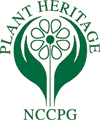
In 1978 the National Council for the Conservation of Plants & Gardens, (NCCPG), was founded in order to preserve the UK's great biodiversity of garden plants for the benefit of horticulture, education and science.
This was done by creating 'National Plant Collections' to encourage the conservation of cultivated plants in the British Isles and by supporting and publishing research into these plants, their origins, their historical and cultural importance and their environments, and helping to educate the public in the importance of cultivated plant conservation.
The charity is organised into area groups, each with its own Committee which includes an Area Collection Co-ordinator.
The NCCPG is now more generally known as Plant Heritage and there are over 650 National Plant Collections® which fall into three categories, Provisional, Full and Scientific.
In 2018 I noticed that there was no National Collection of Arisaema so, as we grew about 10 species as underplanting for the Cardiocrinum and Rowan collections, I contacted our local Collection co-ordinator and the national co-ordinator to see if it would be worthwhile in expanding these to become a third NC® at Redhall. The suggestion was favourably recieved and we built up the collection with a view to submitting it for assessment for NC status in 2020 or 2021.
An application was submitted in 2021 and we were granted, (surprisingly to me), full collection status on 7/9/21.
One of the conditions of holding a collection is that the holders must allow public access to the plants and we are happy to show individuals or small groups around the collection if given a few weeks notice by email. No charge is made for a visit but we welcome a donation towards the upkeep of the collection. See the Visits page for more details.
We are quite difficult to find and I suggest that visitors look at or download a map of the route to Redhall from various points of origin.
It is also a condition of holding a National Collection that the collection material is made available to the public. We do this by donating plants to Plant Sales and offering them for sale to visitors.
